LE ORIGINI – THE ORIGINS
Alla base di un grande talento c’è innanzitutto il talento. Poi la passione e il lavoro fanno il resto. Quando a 16 anni Mirkò dipinge su un grande piatto in ceramica il bacco di Caravaggio senza sbagliare un colore, chi ha avuto la fortuna di vederlo ha subito intuito che il futuro di quel giovane sarebbe stato l’arte e che dell’arte sarebbe stato protagonista. Il percorso di Mirkò segue la tradizione classica dei grandi artisti del passato, ai quali si è sempre ispirato, ed è basato essenzialmente su studio e sacrificio.Consegue il diploma di Maestro d’Arte a Salerno e intanto lavora come apprendista presso diversi laboratori ceramici a Vietri sul Mare, suo paese natale. Conosce e si fa apprezzare da un artista olandese stabilitosi a Vietri, Frans Brugman, considerato l’ultimo erede del “Periodo tedesco” della ceramica vietrese. Brugman diventa suo maestro, suo mentore ed esempio di vita. In pochissimi anni Mirkò raggiunge dei livelli tecnici e artistici altissimi. Attraverso studi e sperimentazioni dettate solo dalla sua inventiva, ottiene delle tonalità cromatiche mai viste prima sulla ceramica. Ma il risultato più sorprendente arriva quando, praticamente dal nulla, crea uno stile personale che incontra immediatamente il gusto di raffinati collezionisti ed esperti d’arte.
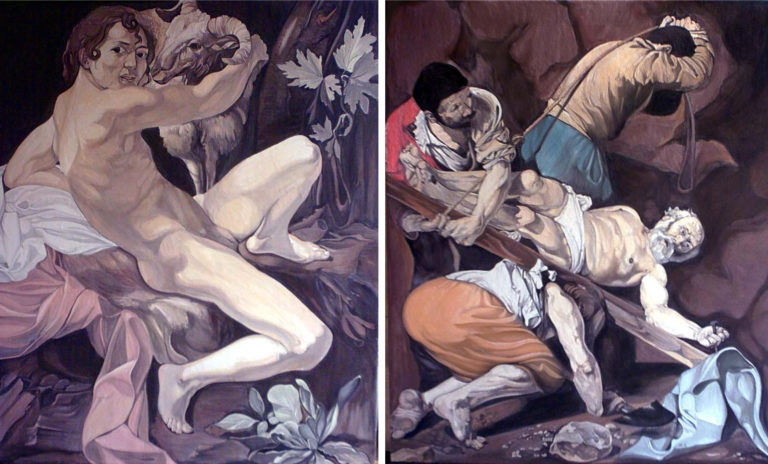
At the root of any great skill is, above all, talent, then passion and work do the rest. When he was only 16 years of age Mirkò painted the Bacchus of Caravaggio on a large ceramic plate without missing out a colour, those who had the good fortune to see this immediately realized that the future of this young man would be art and that art would be the protagonist . Mirkò has always been inspired by the great artists of the past, and his path led him towards classical traditions, primarily study and sacrifice. He graduated as a Master of Art in Salerno and in the meantime he became an apprentice at several ceramic workshops in his home town of Vietri sul Mare. He also met and was appreciated by Frans Brugman, a Dutch artist who had settled in Vietri, and was considered the last heir of the “German period” on the Amalfi Coast. Brugman later became not only Mirkò’s teacher but also his mentor. In a few years Mirkò reached the highest technical and artistic levels. Through studies and experiments dictated to him only by his imagination, he produced tones on ceramics never seen before. But the most surprising result came when, almost out of the blue, he created a personal style that immediately met the tastes of some of the most refined collectors and art experts.
LA RICERCA DI UNO STILE – STYLE RESEARCH
Ogni artista si esprime attraverso il suo stile in maniera inconfondibile che, per quanto possa essere originale, è quasi sempre frutto di una ricerca e di un’evoluzione artistica. E’ facile individuarne le varie fasi nelle opere giovanili e sperimentali di ciascuno di essi. Quello di Mirkò, invece, non è frutto di un percorso ma di un’idea esplosiva, la stessa esplosione che scompone in miriadi di frammenti colorati le sue creazioni pittoriche. Mirkò raccoglie nella sua esperienza i suoi studi, gli insegnamenti di Frans Brugman, e tutta l’arte che riesce a divorare, dalle pitture murali dei cavernicoli alle più controverse creazioni contemporanee, e d’impulso costruisce il suo stile, strutturato e completo fin da subito. Ciò che prende forma sotto le sue mani è un orgasmo di colori, un insieme ipnotico di linee che formano straordinarie scene oniriche. Definire il suo stile non è facile. Sembra di scorgere tra le sue creazioni figure dalla postura babilonese, elementi di cultura preincaica e sprazzi di Bauhaus, tutti convergenti verso una nuova espressione di cubismo, mai definita prima d’ora. Forse si potrebbe azzardare ad inquadrarlo come un’evoluzione diversa del protocubismo. A fare la differenza, oltre allo stile, sono anche i temi delle opere di Mirkò, liberi dal vincolo dell’astrattismo, si presentano con naturalezza e semplicità, con un linguaggio comprensibile a tutti, universale. Le scene e i soggetti rappresentati, diffusamente noti nell’arte e nella cultura in genere ma inediti nella forma e nel colore, sembrano comunque appartenere ad un ricordo congenito e collettivo. E’ nelle pieghe di questo mistero che si nasconde la sua straordinaria forza.
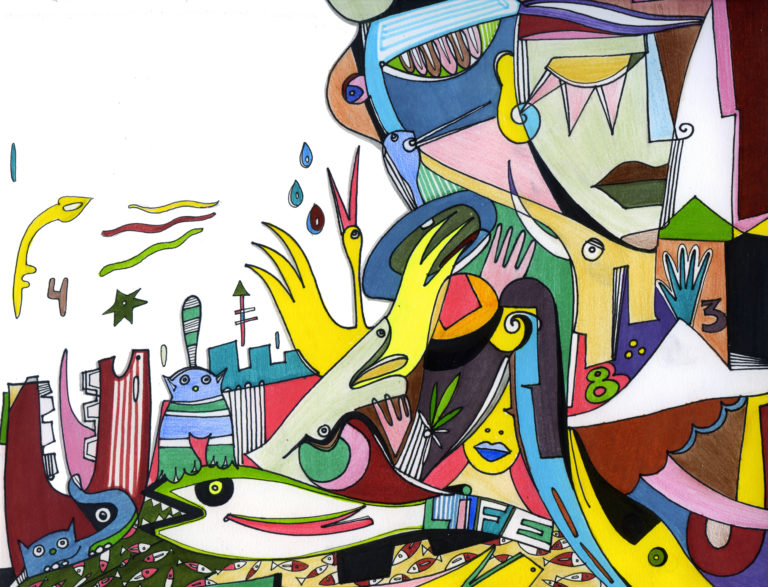
Each artist expresses himself through his own personal style, and no matter how original, it is almost always the result of research and an artistic evolution. It is easy to identify the various stages in Mirkò’s early works and experiments. To Mirkò, however, it is not only the result of a process but an explosion of ideas, an explosion that breaks down into a myriad of fragments which colour his pictorial creations. Mirkò gathered his experiences from his studies, the teachings of Frans Brugman, and all the art that he managed to devour, from the wall paintings of the caves to the most controversial contemporary creations, and impulsively built his style, structured and comprehensive from the very start. What takes shape under his hands is the magic of colours, an array of hypnotic lines forming extraordinary dream like scenes. To define his style is not easy., we see figures from Babylonia, elements of pre-Inca culture and flashes of Bauhaus, all converging towards a new expression of Cubism, never defined before. Perhaps one might venture to classify Mirkò’s works as an evolution of proto Cubism. What makes the difference, in addition to his style, are the themes, free from abstract constraints, they appear naturally and easily, in an universal language, understandable to all. The scenes and subjects represented, widely known in the art and culture world, are unusual in form and colour but seemingly belong to a congenial and collective memory and it is here in the folds of this mystery that hides an extraordinary strength.
SIMMETRICA MENTE – A SYMMETRIC MIND
La ricerca della simmetria è la ricerca della perfezione. Molti grandi artisti del passato si sono cimentati con essa, ma il primo nome che viene in mente quando si dice simmetria è sicuramente quello dell’olandese Maurits Cornelis Escher. Mirkò, nella fase dirompente della sua evoluzione comunicativa, viene attratto dagli artisti più misteriosi ed inquieti, quelli che sono riusciti ad alterare la percezione stessa della realtà. Ma l’incontro con Escher non è casuale, anzi, per certi aspetti è quasi inevitabile. Il suo maestro e grande amico, Frans Brugman, anch’esso olandese, ha collaborato in gioventù con il suo connazionale, e di quell’esperienza racconta spesso i particolari al giovane allievo. C’è un filo invisibile che lega l’Olanda alla Costiera Amalfitana e a Mirkò. Sophie Van Stolk, Escher, Brugman, Vietri, Atrani, Amalfi. Sono i pezzi di un mosaico nel quale si incontrano in perfetta armonia cromatica uomini, donne e luoghi, artisti e sognatori, passato e futuro. Escher visita la Costiera Amalfitana sul finire degli anni venti del secolo scorso. Dalle sue opere possiamo intuire che rimase particolarmente affascinato dalle disposizioni architettoniche dei borghi marinari. L’inestricabile incastro di porte, finestre e balconi, intersecate da scale di diverse forme e misure, colpiscono a tal punto l’artista olandese da diventare la base dei suoi studi prospettici con i quali, attraverso l’inganno dell’occhio, dimostra la sua teoria della falsa tridimensionalità del disegno. La simmetria di Mirkò si discosta da quella escheriana, pur traendone evidente ispirazione. Non rappresentazione pantografata verso la rarefazione di un soggetto, ma ricerca del movimento attraverso la sua staticità. Il suo tratto preciso come la lama di un bisturi riesce a rappresentare immagini quasi identiche, differenti a volte per particolari a prima vista impercettibili. Nella metamorfosi del suo ingegno, Mirkò ha concepito una danza di figure immobili, come impresse in fotogrammi su una pellicola pronta ad avviarsi. Ed ecco il guizzo di un occhio, l’accenno di un sorriso, svelarsi all’osservatore più attento, ecco la magia dell’artista. Come fu per Escher, anche per Mirkò la simmetria è solo una fase di passaggio, meravigliosamente transitoria.
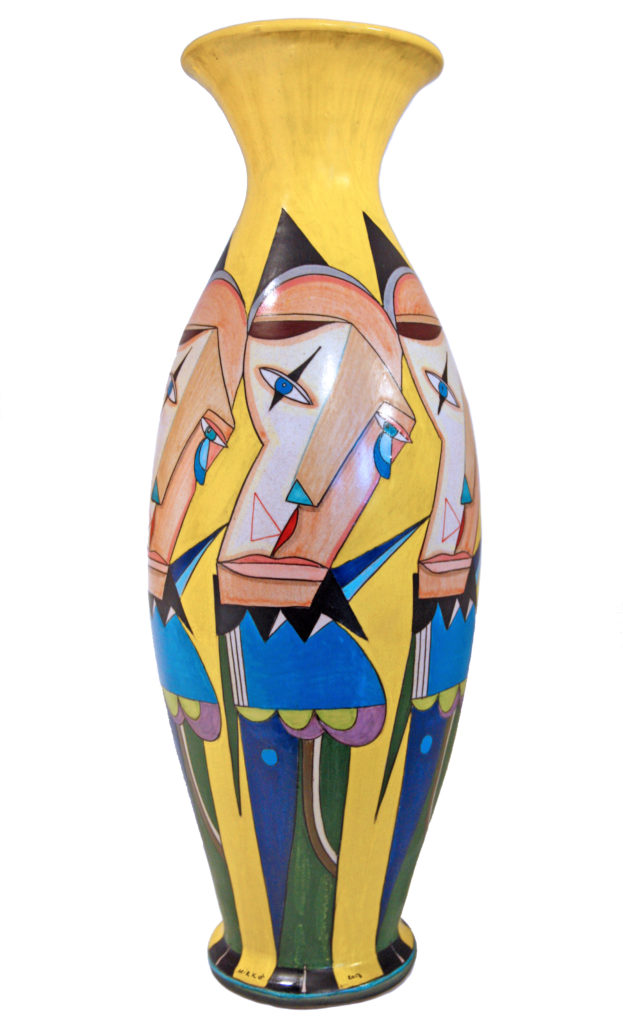
The search for symmetry is the pursuit for perfection. Many great artists of the past have grappled with it, but the first name that comes to mind when you say symmetry is certainly the well known Dutch artist Maurits Cornelis Escher. Mirkò was drawn to this mysterious and restless artist because he was one who managed to alter the perception of reality. Meeting Escher was inevitable as Mirkò had worked with his compatriot, his great teacher Frans Brugman, who would often talk to his young student about his past and acclaimed that there was an invisible thread which linked the Netherlands with the Amalfi Coast and to Mirkò. Sophie Van Stolk, Escher, Brugman, Vietri, Atrani and Amalfi, they are all pieces of a mosaic, a perfect harmony of chromatic men, women, artists, places, and dreamers, past and present. Escher visited the Amalfi Coast in the late twenties, of the last century. From his works it is clear to see that he was particularly fascinated by the buildings and the architecture of the quaint fishing villages. The inextricable interlocking of doors, windows and balconies, intersected by stairs of different shapes and sizes, it had made such an influence on the Dutch artist that it became the font of his prospective studies with which, through the deception of the eye, shows the artists theory of the false three-dimensional drawing. The symmetry of Mirkò differs from that of Escher, while drawing clear inspiration, there is no pantograph representation towards perfection of a subject but a research of movement through its static nature, precise lines as made by a scalpel are almost identical images, which at times change or are imperceptible at first sight. In the metamorphosis of his genius, Mirkò conceived a motionless dance , as imprinted in the frames of a film ready to start, then in a flash of an eye, the hint of a smile, unveiling to the more observant viewer, that is the true magic of the artist. Like Escher, the Symmetry for Mirkò was just a passing phase, marvelously transient.
COLORI MITOLOGICI – MYTHOLOGICAL COLOURS
Quando i nostri occhi incontrano il mito, il nostro subconscio si agita come un serpente nelle nere acque di un pozzo profondissimo. Questa sensazione, questa agitazione, Mirkò la conosce bene, scorre nelle sue vene, ed è fuoco e ghiaccio mentre con i suoi pennelli ci regala nuove creature multicolori. Nulla è superficiale, niente è lasciato al caso. Ogni opera è frutto di un accurato studio antropologico, di una appassionata ricerca. Mirkò si approccia alla rappresentazione del mito iniziando da quello classico. Il suo estro ci mostra, in maniera assolutamente originale, i soggetti e le scene più conosciute, in primis quelle della mitologia greca. Poi la sua profonda sete di conoscenza lo spinge decisamente oltre. Si documenta sui miti delle civiltà sepolte, di popoli lontanissimi e dimenticati, coglie il sottile legame che unisce storie e personaggi distanti tra loro nello spazio e nel tempo. Poi, unicamente con l’aiuto dei colori, ce li racconta alla sua maniera. Mirkò non solo dipinge gli dei abbandonati e gli eroi immortali, con le sue pennellate squarcia veli millenari, dietro ai quali si cela un’età dell’oro ormai perduta. Per questo motivo il carattere ipnotico delle sue opere si amplifica e costringe l’osservatore alla ricerca di un frammento di memoria che giace dormiente, confuso tra i ricordi dell’adolescenza e tra i sogni dell’infanzia. La rappresentazione del mito ha significato per Mirkò un’evoluzione fondamentale della sua espressione artistica, con esso ha potuto superare i limiti comunicativi, endemici ad una parte dell’arte moderna, trovando un linguaggio universale, libero da ogni tipo di vincolo concettuale, accessibile alle persone di ogni cultura e nazione della terra.
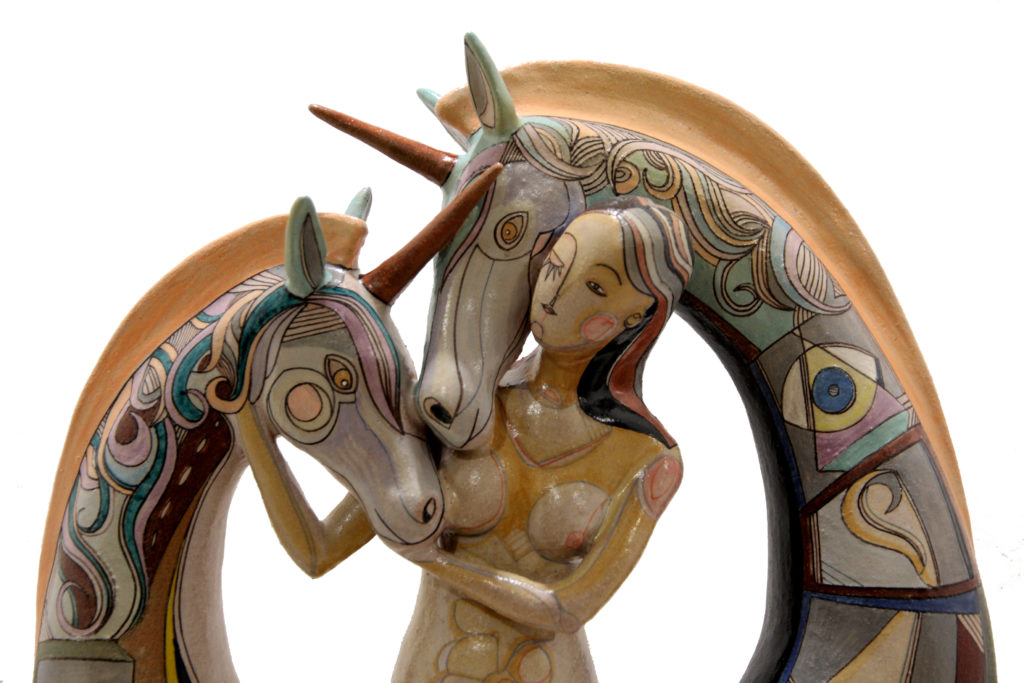
Our subconscious is often aroused, even awakened, when we come face to face with a myth, and Mirkò knows this, he feels this every time his brushes create a new multicoloured creature. Each work is the result of a very careful anthropological study, nothing is superficial or left to chance, it is a passionate pursuit which begins with the classics. Mirkòs talent and deep thirst for knowledge portray the subjects and places, primarily of Greek Mythology, in a very unique way, and the myths of buried civilizations or long forgotten peoples are all captured in subtle links between stories and characters far apart in space and time, it is with his colours that Mirkò begins to tell his stories. He not only depicts the abandoned gods and immortal heroes, but with his brushstrokes he rips away millennial veils, behind which lay a lost golden age, and with which the hypnotic nature of his work leads the onlooker to search their memories for fragments which lay dormant between those adolescent and childhood dreams.The representation of the myth was fundamental for the evolution of Mirkò’s artistic expression, he has also been able to overcome the limitations of communication, endemic to a part of modern art, finding a universal language, free from any kind of constraint, accessible to people of every culture and nation on this earth.
NOTE DI COLORE – A NOTE OF COLOUR
Silenzio, accordi strumentali, tre colpi di bacchetta e via, i pennelli corrono fluidi e scivolano sullo smalto candido, rincorrendo melodie misteriose, nascoste nei pigmenti e nell’acqua. Mirkò, pennellata dopo pennellata, dipinge la musica, con il suo tratto inconfondibile. Ed ecco comparire musicisti, strumenti e orchestrali, avvolti da note danzanti. Batteristi, violinisti, chitarristi, complessini blues e jazzisti neri, bande di paese e suonatori da osteria. Come sempre, protagonista è il colore, vivace e brillante, capace di esaltare ogni particolare. Una bacchetta sospesa sopra un piatto vibrante, le guance gonfie di un sassofonista, le dita agili di un pianista. Ogni immagine ferma nel colore riflette la luce in modo diverso, cambiando con la posizione dell’osservatore, creando l’illusione di un movimento e, forse, di un suono.Colore e musica sono due linguaggi che esprimono le stesse emozioni. Spesso si fondono e insieme raggiungono profondità dell’anima altrimenti inaccessibili. Jimi Hendrix, virtuoso della chitarra, artista di fama mondiale, quando provava con il suo gruppo, per spiegare una tonalità o un accordo, lo faceva tramite i colori. “Questo deve essere viola lucido e questo fuoco verde”. Per Hendrix la musica era colore, per Mirkò il colore è musica.
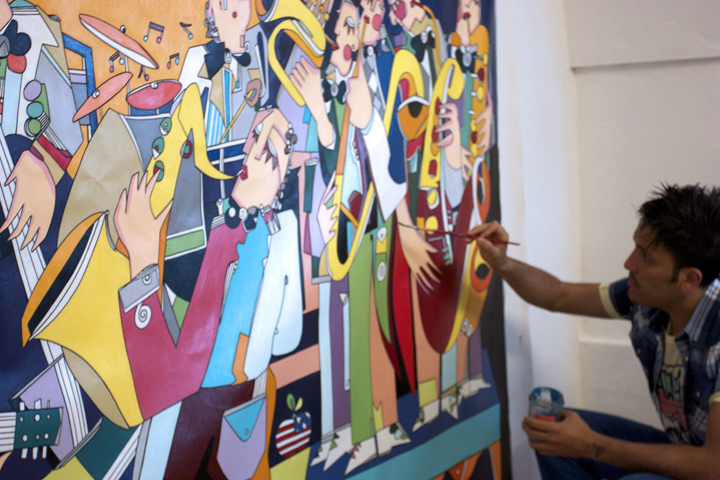
Silence, instrumental arrangements, then like magic it all begins, the brushes start to glide across the white enamel, chasing mysterious melodies hidden in the pigments and water. Then suddenly, stroke by stroke Mirkò paints and his unmistakable music begins. Musicians appear, orchestral instruments surrounded by dancing notes , drummers, violinists, guitarists, blues bands, jazz musicians , local country bands and even tavern musicians, and the leading protagonists, as always, are the lively bright colours which enhance every detail from a suspended drumstick above a vibrating symbol, the puffed cheeks of a saxophonist, the nimble fingers of a pianist., every picture, still, in colour, reflects the light in so many different ways, ever changing with every position of the observer, creating the illusion of a movement, and perhaps, of a sound. Colour and music are two languages which express the same emotions. Often they merge together and reach the inaccessible depths of our souls. Jimi Hendrix, guitar virtuoso and world-renowned artist, when he practised with his group and had to explain a chord or a key it would be through colour: “This must be polished purple and fiery green. For Hendrix music was colour and for Mirkò colour is music.
ARTE QUOTIDIANA – EVERYDAY LIFE ART
Mirkò è un artista imprevedibile. E’ capace di rappresentare luoghi e persone distanti nello spazio e nel tempo, paesaggi impossibili o mostruose creature inesistenti. Poi si affaccia al balcone di casa e riesce a cogliere in una scena quotidiana l’essenza stessa della vita. Entrano così a far parte del repertorio di Mirkò vecchi giocatori di carte, suonatori ambulanti e avventori di locande, sullo sfondo scorci e profili di case, cupole e campanili che rimandano alla sua Vietri ed a tutta la Costiera Amalfitana. Colori e rappresentazione di questi soggetti comuni sono gli stessi delle opere più impegnate e significative, con la differenza che ogni singolo particolare è vivo e reale, fissato per un attimo negli occhi dell’artista e poi per sempre nei colori delle sue creazioni. Il messaggio è profondo. La vita quotidiana può essere arte, senza smettere di essere autentica.
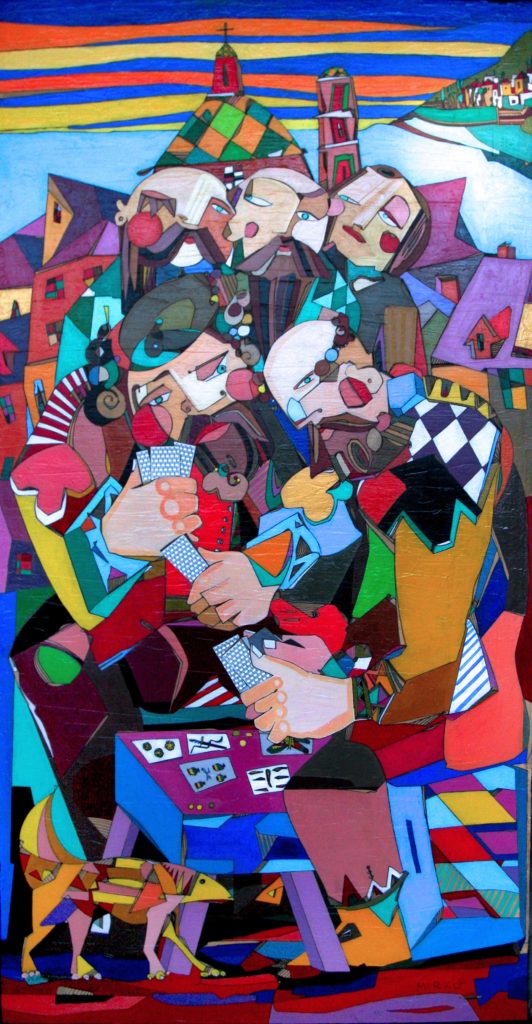
Mirkò is an unpredictable artist, capable of representing people and places distant in space and time, incredible landscapes or nonexistent monstrous creatures, then just by looking out from a balcony, he can capture an everyday scene and the very essence of life, and that is why the folk, the background views, the profiles of the houses, domes and bell towers, that lead to his Vietri on the Amalfi Coast, become a part of Mirkò’s repertoire. The colours and representation of these everyday subjects are the same as in any other significant work, each detail is alive and real, attached to a moment in the eyes of the artist, and then forever in the colours of his creations.
The message is profound. Everyday life can be art, without ever ceasing to be authentic.
LE FORME E GLI SMALTI – THE ENAMELS AND SHAPES
Il ceramista è un ponte tra l’uomo e la terra. L’argilla plasmata si evolve e si eleva verso raffinate forme artistiche. La ceramica è stata sempre considerata, ingiustamente, “arte minore”, ma il suo fascino è indiscutibile. Attraverso la ceramica è possibile uscire realmente dalla bidimensionalità della pittura senza dover rinunciare all’espressività del colore. Dopo aver individuato il suo stile, dopo aver stabilizzato il suo linguaggio artistico, Mirkò avverte la necessità di modificare lo spazio espressivo sul quale dipinge, di plasmare ceramiche che aderiscano completamente alle sue esigenze narrative. Rivolge quindi la sua attenzione verso forme vascolari sempre più audaci, a volte dal carattere antropomorfo o zoomorfo. Anche le plastiche si avviano verso una stilizzazione personalizzata e originale. Stabilita la forma, è il momento dello smalto, in alcuni casi protagonista indiscusso della ceramica. Mirkò capisce di non poter affidare ad uno smalto di produzione industriale il suo messaggio artistico. Decide quindi di individuarne uno più consono alle sue esigenze espressive ed inizia una meticolosa sperimentazione, che lo porterà ad elaborare prodotti sempre più affascinanti. Nascono così smalti cremosi e brillanti, adatti ai colori forti e decisi usati dall’artista, ma capaci di reggere con personalità gli spazi vuoti e le assenze di colore. Le pennellate di Mirkò si avvolgono completamente intorno alle forme ceramiche. Sembra quasi che siano i suoi pennelli e i suoi colori a plasmare la creta, a modificare la forma della terracotta, assecondando le esigenze di un colore o di una figura nella ricerca del suo spazio vitale.
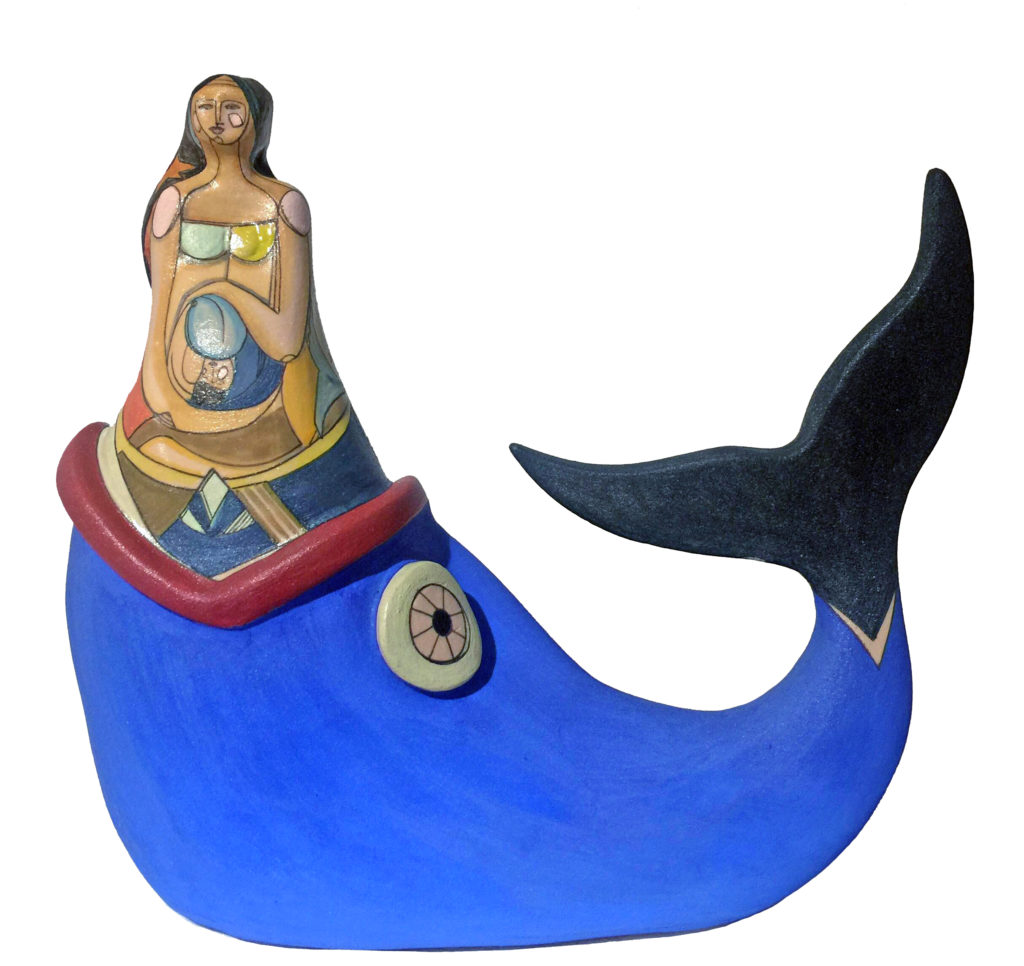
A potter could be described as the bridge between man and earth. To begin with the clay is molded then it evolves and so becomes a refined form of art . Pottery was always considered, though wrongly, “minor art”, but its appeal is undeniable. With ceramics it is possible to move away from the two-dimensionality of painting without sacrificing the expressiveness of colour.
After identifying his style and artistic language, Mirkò found the need to change the expressiveness on that which he paints, to shape ceramics that adhere fully to his narrative requirements. He then turned his attention to vascular forms, increasingly bold, sometimes of an anthropomorphic or zoomorphic character.
Having established the form, to reproduce his artistic message even further, Mirkò knew that the enamel he required could not be of industrial production, so he decided to find one best suited to his expressive needs and began a meticulous research, which led him to develop products that were more appealing. This is why his enamels are creamy and bright, suitable for strong colours, but with personality, able to cope with gaps and absence of colour.
The brushstrokes of Mirkò wrap completely around the ceramic forms created by him, It is almost as if his brushes and colours mold the clay, satisfying the needs of a colour or a shape which are vital.
LA GIOCONDA D’AMALFI – THE GIOCONDA OF AMALFI
Uno sguardo indecifrabile, un sorriso impercettibile, un’ossessione per il suo creatore, e un’attrazione irresistibile per l’intera popolazione mondiale. Questo, in sintesi, il quadro più famoso del pianeta. Eppure il mistero più grande legato alla Gioconda va oltre la sua storia, ed è visibile a tutti. La donna del dipinto è di una bellezza modesta, anche per la sua epoca, e non sembra manifestare particolare grazia. Eppure, già a partire dagli allievi di Leonardo da Vinci, molti artisti hanno riprodotto quel volto e quel paesaggio, forse cercando di coglierne l’essenza nascosta. Dopo quasi cinque secoli, anche Mirkò non ha resistito alla tentazione, al richiamo oscuro di questo dipinto. Dopo un primo approccio, nel quale ha voluto esprimere la sua personale Gioconda, tra cubismo e pop art, Mirkò ha elaborato una versione legata alla storia della duchessa Giovanna d’Aragona. A cambiare questa volta non sono solo colori e linee che compongono la dama centrale, ma anche il paesaggio in secondo piano. Le campagne toscane lasciano il posto alle torri e ai profili rocciosi tipici della Costiera Amalfitana. La donna raffigurata, come detto, non è la stessa. Dalla misteriosa Gioconda si passa alla sfortunata nobildonna d’Amalfi. Ma il tratto è sempre quello inconfondibile dell’artista vietrese. Pezzi di colore, alcuni dall’aspetto antropomorfo, compongono la stessa inconfondibile figura, tra linee che si avvolgono in spirali o che fanno da confine ad inaspettati quanto sorprendenti rivoluzioni cromatiche. La dama raffigurata da Mirkò, seppure assemblata secondo i canoni dell’arte moderna, manifesta una continuità concettuale con l’originale del maestro toscano, nella completa mancanza di beltà e grazia. La bellezza, però, nelle interpretazioni di Mirkò, si manifesta negli accostamenti dei colori, che mettono inspiegabilmente in risalto parti anatomiche o paesaggistiche, e nelle forme accattivanti dei pezzi di colori che compongono il dipinto. La Gioconda, intanto, continua il suo viaggio attraverso i secoli, rigenerandosi in ogni epoca, senza mai svelare il mistero magnetico del suo fascino.
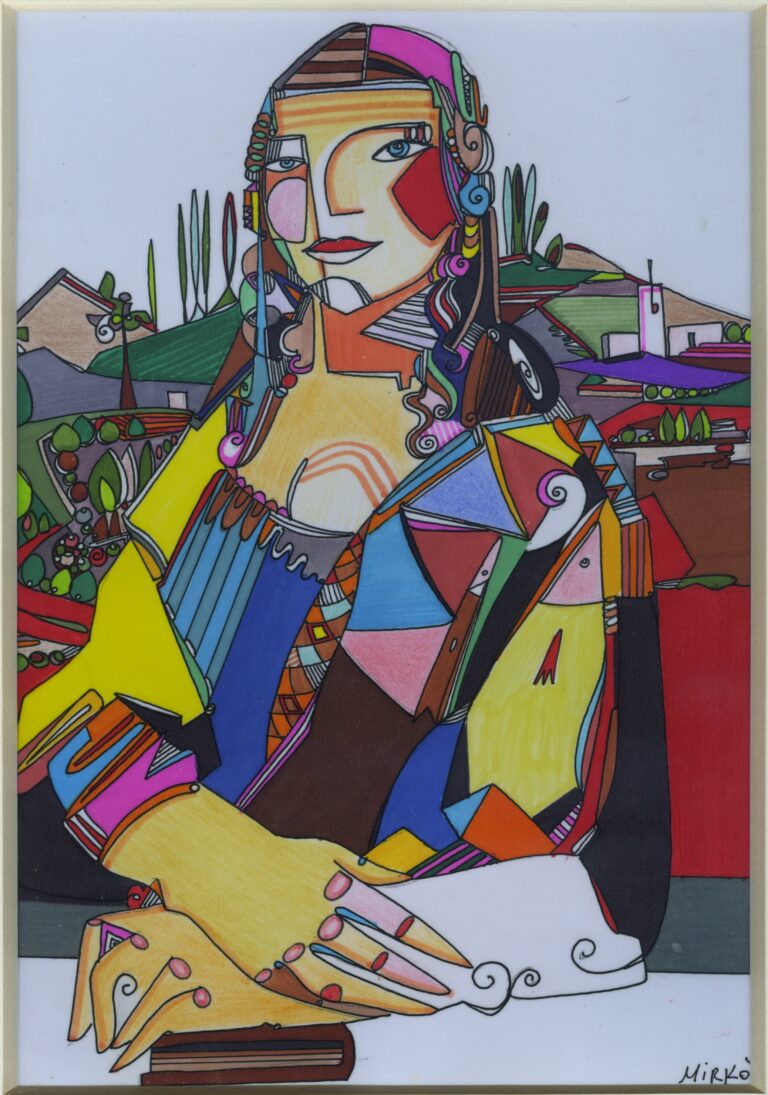
An indecipherable look, an imperceptible smile, an obsession with its creator, and an irresistible attraction for the entire world population. This, in short, is the most famous picture on the planet, yet the greatest mystery linked to the Mona Lisa goes beyond its history, and is visible to everyone. The woman in the painting is of modest beauty, even for her age, and does not seem to manifest particular grace. And yet, as early as the pupils of Leonardo da Vinci, many artists have reproduced her face and landscape, perhaps trying to grasp its hidden essence.
After almost five centuries, even Mirkó has not been able to resist the temptation or the obscure call of this painting. After a first approach, in which he wanted to express his personal Gioconda, between cubism and pop art, Mirkó has elaborated a version linked to the story of the Duchess of Amalfi, Giovanna of Aragon. Here the changes are not only the colours and lines which make up the central lady, but also the landscape in the background. The Tuscan countryside gives way to towers and rocky outlines, typical of the Amalfi Coast. Therefore, the woman depicted, is not the same, the mysterious Gioconda is transformed into the unfortunate noblewoman of Amalfi by the hand of the unmistakable artist from Vietri. The wonderful colours, some with an anthropomorphic appearance, make up the same unforgettable figure, between lines that wrap themselves in spirals or that act as a boundary to unexpected astonishing chromatic revolutions. The lady depicted by Mirkó, although assembled according to the canons of modern art, manifests a conceptual continuity with that of the original Tuscan master, in complete lack of beauty and grace. The beauty, however, in the interpretations of Mirkó, is manifested in the combinations of colours, which inexplicably highlight the anatomical and landscape parts, and in the captivating shapes of the pieces of colours which make up the painting. La Gioconda, meanwhile, continues its journey through the centuries, regenerating itself in every age, without ever revealing the magnetic mystery of its charm.
UNA STORIA AMALFITANA – AN AMALFITAN STORY
Per anni Mirkò, forte delle affermazioni nazionali e internazionali, ha tenuto una sua galleria a Vietri sul Mare, dove far confluire le sue nuove opere e le sue sperimentazioni. Ma il paese natale non è riuscito ad essere il palcoscenico che l’artista stava cercando. Tutto cambia quando due fratelli, imprenditori amalfitani (Andrea Sotero e Salvatore Sotero) gli propongono di dedicargli una galleria esclusiva nella piazza del duomo di Amalfi, uno dei contesti più affascinanti dell’architettura mondiale. Una proposta che Mirkò decide di accettare, legando la sua arte alla splendida cittadina che dà il nome all’intera costiera. In pochi mesi la galleria viene disegnata per accogliere nel migliore dei modi le opere dell’artista vietrese, che dedica ad Amalfi il tema della mostra d’inaugurazione che diventerà anche la base di una linea permanente. Tutte le opere esposte traggono ispirazione dalla tragica storia di Giovanna d’Aragona, una sfortunata nobile vissuta tra la fine del 1400 e l’inizio del 1500. Giunta ad Amalfi in sposa ad un duca della famiglia Piccolomini, ne rimane presto vedova, risposandosi segretamente con un suo maggiordomo, dal quale ebbe anche tre figli. La famiglia di lei però, disapprovando il legame, la fece trucidare insieme con i suoi figli, dopo averla tenuta rinchiusa nella torre dello Ziro, situata sulle colline di Amalfi. La triste storia della donna ha ispirato per secoli tragedie, novelle e romanzi, commuovendo per la sua crudeltà. Ovviamente Mirkò, curioso e attento alle storie legate ai luoghi della sua costiera, non può resistere all’idea di inaugurare la sua nuova galleria amalfitana traendo ispirazione da una vicenda così affascinante. E come ogni idea dell’artista, in poco tempo le sue mani la trasformano in opere pronte a lasciare incantati, a suscitare la meraviglia della bellezza. Ceramiche e quadri realizzati con i consueti colori brillanti, segno distintivo dell’artista vietrese, ciascuno narrante una parte del racconto, vengono inseriti in un contesto espositivo molto suggestivo. E’ un perfetto inizio per una nuova fase della vita artistica di Mirkò.
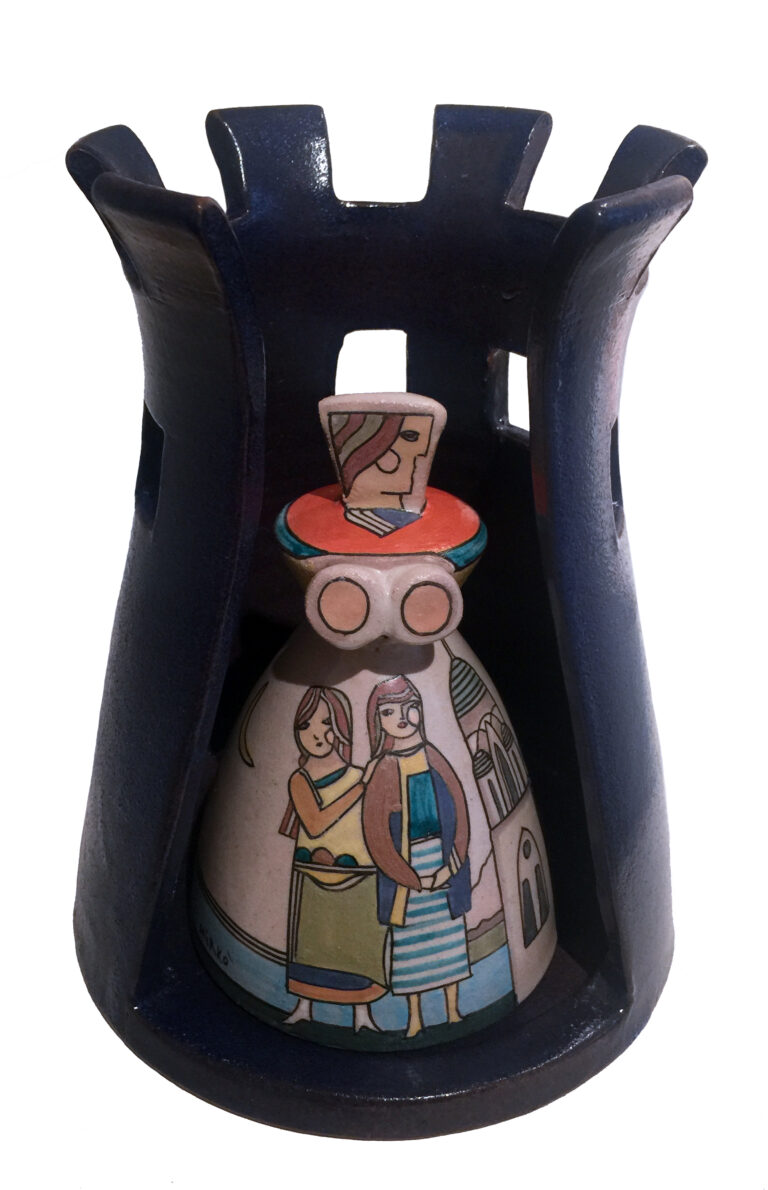
For many years now Mirkò’s art has been recognized nationally and internationally, at one time he had his own small modest gallery in Vietri sul Mare, where he could channel his new ideas and works. However, Vietri was not to be the stage he deserved, then one day an entrepreneur from Amalfi (Andrea Sotero) offered Mirkò the possibility of opening his own exclusive gallery in the main square of Amalfi, one of the most fascinating contexts in the world of architecture – a few steps from the famous Cathedral of Saint Andrea. Naturally Mirkò decided to accept this unexpected offer and within a short time Mirkò was able to inaugurate his exhibition, dedicated to Amalfi, which this divine coast derives its name from. Nearly all the works that were put on display were inspired by the story of Giovanna d’Aragona, a noblewoman who lived between the end of 1400 and the beginning of 1500. She came to Amalfi as she had been betrothed in marriage to a duke, a member of the Piccolomini family. Unfortunately she was soon to become widowed, later she fell in love and in secret she married the head Butler, with whom she had three children. The family strongly disapproved of the relationship so she was put away in the Ziro Tower, situated on one of the Amalfi hillsides. The sad story of this lady, has for centuries, inspired novels, stories and plays. Mirkò, naturally curious and attentive to stories related to different sites along the coastline, could not resist the idea of inaugurating his new gallery with works inspired by the Duchess of Amalfi. Like so many ideas of Mirkò, in no time his works were ready, ceramics and paintings in the artist’s unmistakeable bright colours which left everyone spellbound. Each exhibit narrated part of the story and this very impressive exhibition was the perfect start to a new artistic phase in the life of Mirkò.
L’ULTIMA CENA – LAST SUPPER
Scene religiose così articolate non sono mai semplici da rappresentare. Inoltre bisogna tentare di evitare eccessivi accostamenti ai grandi capolavori dell’arte rinascimentale, anche se è impossibile non tener conto della loro influenza. Qui l’artista decide di comporre la scena secondo uno schema raramente utilizzato per l’Ultima Cena. I commensali si trovano intorno ad un tavolo rotondo, come i cavalieri dei cicli bretoni o arturiani, e non rettangolare come vuole l’iconologia classica. Seguendo il suo stile, Mirkò adegua le figure e i colori alla forma del vaso, rendendo tutto armonioso, e sceglie di non usare toni accesi, affidandosi ad uno smalto poco lucido, per facilitare la lettura dell’opera fin nei minimi particolari. Al centro della scena, in fondo al tavolo, c’è un condannato a morte, che per ora è seduto tra gli uomini, ma che presto diventerà un dio. Particolare fondamentale è l’inversione della prospettiva dei protagonisti. Pur se in primo piano, gli apostoli vengono rappresentati di statura inferiore a quella di Gesù, che si impone per dimensione e geometria. Prima ancora che in suo nome si fondasse una religione, prima ancora che le sue parole diventassero un testo sacro, quest’uomo era già grande, perché grande era la statura della sua anima. Questo il messaggio dell’artista.
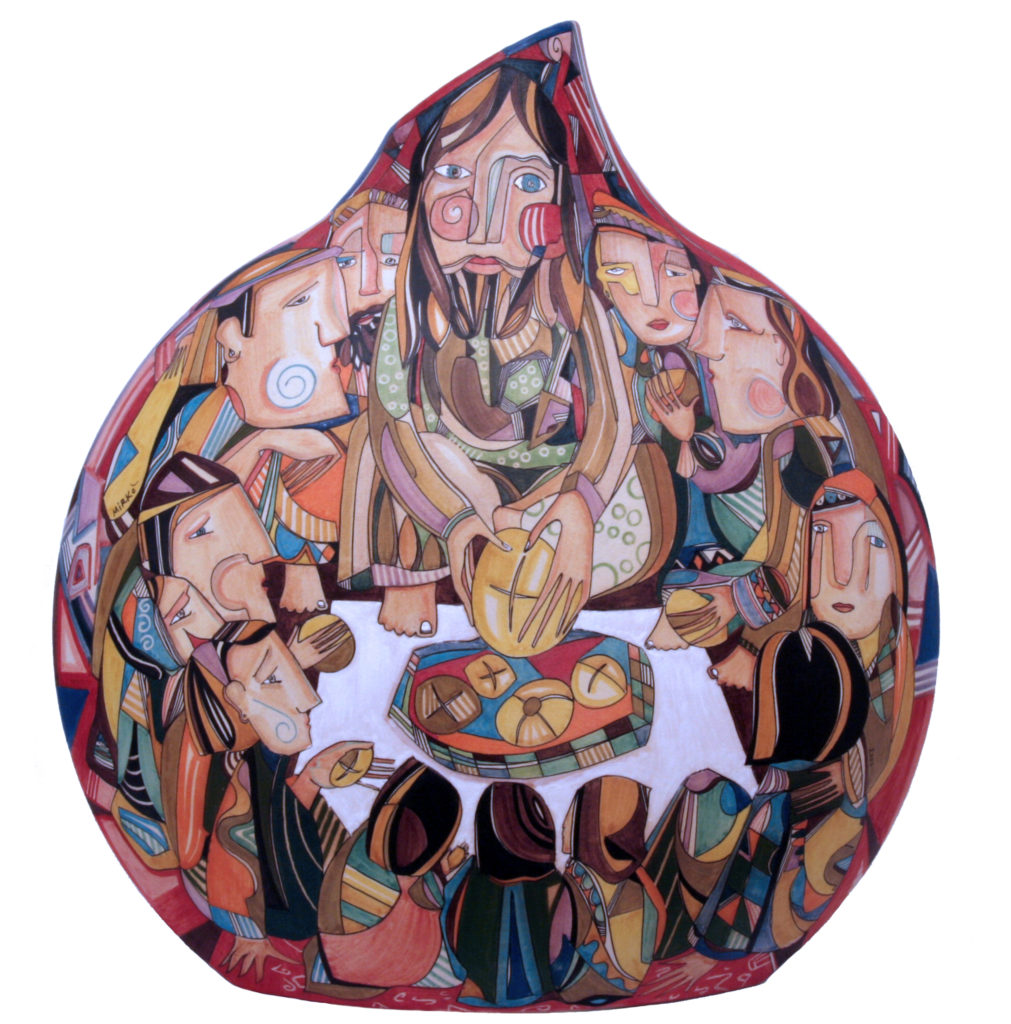
Representing articulated religious scenes is never an easy task. Furthermore, trying to avoid excessive combinations or being influenced by the great masterpieces of the Renaissance period is almost impossible. Here the artist’s decision is to make the scene according to a scheme rarely used for The Last Supper. The diners are seated around a table, like the Bretons and King Arthur’s Knights of the Round Table, and in his style, Mirkó adapts the figures and colours to the shape of the vase thus making everything harmonious, relying on just a soft glaze and not bright colours to facilitate the reading of his work, down to the finest and smallest detail. At the centre of the scene, to the back of the table, seated with the others, there is a man, a man who has been condemned to death, but who will soon become a god. Moreover, imposed by size and geometry, the inversion of the pratagonists here is fundamental, even if the Apostles are seated in the foreground, they are of minor stature to that of Jesus, simply because even before his religion was founded in his name, even before his words became a sacred text, this man was already great, his soul was immense, and this is the artist’s message.
TAUROSTARDUST
Il Minotauro incarna contemporaneamente la bestialità primitiva e l’amore incontrollabile, è al contempo carnefice e vittima, animale e uomo, maschio e femmina, ferocia e tormento. L’immensa solitudine a cui è condannato è la causa della sua diversità, come la solitudine a cui gli artisti affidano l’estro creativo e che gli uomini comuni, confinati nei luoghi senza dialogo, incontrano nel confronto con la morte è tramite le meccaniche del cuore che Mirkò riesce liberare un mostro confinato in un labirinto di orrori. In quest’opera l’artista di Vietri sul Mare intreccia il mito alle esperienze personali, ai viaggi, all’amore per la sua terra. Per poter raccontare la storia progetta insieme al suo amico scultore Fabio Marino un busto ispirato all’ arte Cicladica. Mirkó ha così una sorte di tela dove poter dipingere e raccontare la sua storia. La pancia del Minotauro diventa così un labirinto in cui perdersi , un labirinto che ricalca quello della cappella di san Severo di Napoli. Le rosse braccia si trasformano nelle colonne del tempio di Cnosso. Sui fianchi e sulla parte posteriore dell’opera Minosse, quasi impietrito , assiste all’ accoppiamento tra il toro bianco e Pasifae, accoppiamento simbolo della vita e che seguendo la colonna vertebrale dell’essere conduce al suo cervello. Opposto al viso del Minotauro troviamo Dedalo, l’architetto, simbolo della ragione e dei sogni e dei progetti dell’uomo. Il cervello di Dedalo (anch’ esso un labirinto che porta alla ghiandola pineale che secondo il mito é la sede dell’anima) é incapsulato nell’ uroboro, serpente che si morde la coda, antico simbolo alchemico dell’eternità e dell’ infinito ripetersi delle cose. Immancabile infine l’omaggio a David Bowie che interpretò il Minotauro nel suo concept album “Outside”, uno spietato artista contemporaneo che uccide una ragazzina per esporla come macabra opera d’arte, celebrato da Mirkò nell’anno della sua fine.
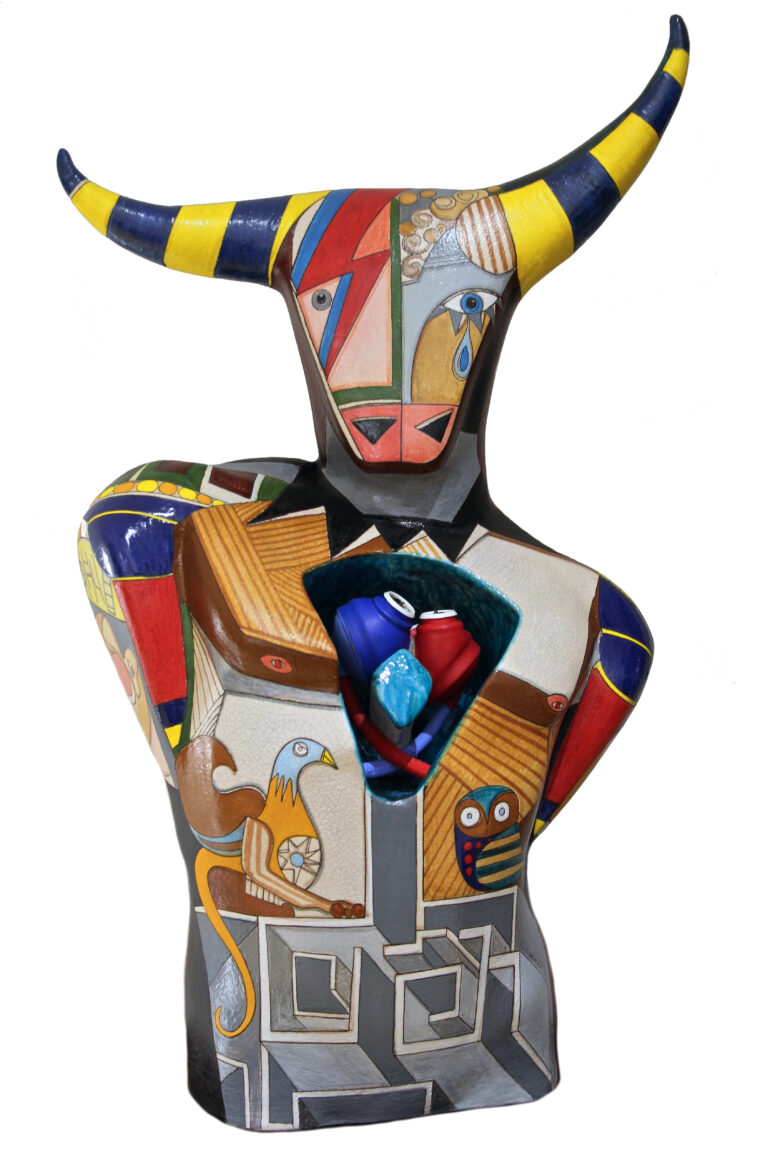
The Minotaur, embodying both primitive beastliness and uncontrollable love, is, at the same time, the excutioner and the victim, the animal and the man, male and female, cruelty and torment. The unbearable solitude he is doomed to is the cause of his diversity. The solitude to which artists entrust the creative flair and which ordinary men, confined to places where no communication is possible, have to come to terms with when death looms. It is through the impulses of the heart that Mirko, an artist from Vietri sul Mare, manages to set free a monster confined to a labyrinth of horrors. In this work the author identifies the myth with his personal experiences, travels, and the love for his motherland. The creation of a bust inspired to the Cycladic art together with his friend, the sculptor Fabio Marino, enables Mirko to tell his story on a kind of canvass. This way the Minotaur’s belly becomes a labyrinth where to lose oneself, a labyrinth resembling the one in San Severo chapel in Naples. The red arms are turned into the pillars of the Knosso temple.On its sides and on the back of the work the stunned Minos witnesses the mating of the white bull with Pasifae. It is the mating symbolizing life that through the spine of the being leads up to the brain. Facing the Minotaur is Dedalus, the architect symbolyzing reason as well as man’s dreams and projects. Dedalus’s brain,( itself a labyrinth leading to the pineal gland that according to the myth is the seat of the soul) is incapsulated in the uruboro, a snake biting its tail, an old alchemic symbol of eternity and of the endless recurring of things Last but not the least, the homage to David Bowie, who performed the Minotaur in his concept album ‘Outside’, a ruthless artist of our time who kills a young girl in order to exhibit her body as a macabre work of art, an artist that Mirko celebrated in the year of his death.

Tratto dal libro – Adapted from the book: TRACCE UNIVERSALI, di Francesco Collano
Lo scrittore – The writer, Francesco Collano